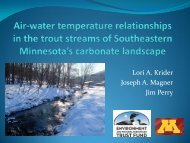Minnesota Water Resources Conference - Water Resources Center ...
Minnesota Water Resources Conference - Water Resources Center ...
Minnesota Water Resources Conference - Water Resources Center ...
You also want an ePaper? Increase the reach of your titles
YUMPU automatically turns print PDFs into web optimized ePapers that Google loves.
Poster Session 4:45–5:45<br />
BOOK OF ABSTRACTS<br />
Tuesday, Monday, October 27 23<br />
Regionalization of Ground <strong>Water</strong> Systems in Support of <strong>Water</strong> <strong>Resources</strong> Sustainability Atlases in<br />
<strong>Minnesota</strong><br />
Roman Kanivetsky, University of <strong>Minnesota</strong>, kaniv001@umn.edu; John Nieber, University of <strong>Minnesota</strong>; Boris Shmagin, South<br />
Dakota State University; David Mulla, University of <strong>Minnesota</strong>; Heidi Peterson, University of <strong>Minnesota</strong>; Francisco Lahoud,<br />
University of <strong>Minnesota</strong><br />
Organizing knowledge for water resources sustainability requires a new approach in regionalization of<br />
terrestrial hydrologic system. We propose an approach based on a definition of the hydrological unit as the land<br />
area that integrates all components of the terrestrial hydrologic system. Such nomenclature provides not only a<br />
much fuller characterization of the hydrologic system than using just the component parts such as aquifers or<br />
confining beds, but it is also a prerequisite to study water resources sustainability. The hydrologic response of<br />
such hydrologic units, once established based on measurements at an appropriate scale, can be directly related<br />
to the hydrologic response of geometrically similar hydrogeologic units elsewhere. This similarity allows the<br />
scaling (up or down) of hydrologic response based on the absolute size of the unit.<br />
Soil Seed Bank Analysis of a Drained Peatland in East-central Minnesot Pre- and Post-Grading: a Case<br />
Study for Wetland Restoration<br />
Allyz Kramer, SEH Inc., akramer@sehinc.com<br />
This study evaluated native seed bank viability in a peatland subjected to prolonged drainage for sod production<br />
in Ham Lake, <strong>Minnesota</strong>. The study area was within a proposed wetland restoration and mitigation site, and<br />
included assaying the soil seed bank prior to, and immediately after, site grading. The goals of the study related<br />
to wetland restoration and future management activities were to quantify viable plant species present in surface<br />
and subsurface seed banks; evaluate native origins of viable germinants; and, determine relative densities of<br />
viable hydrophytes in the seed bank. Both assays included a high density of weedy species associated with moist,<br />
disturbed sites and waste places, which provide a strong argument for scraping and removing extant vegetation<br />
prior to attempting native vegetation reestablishment. Spreading surface soils around the site during grading<br />
activities should be avoided because of relative densities of undesirable weedy species contained in surface soils.<br />
<strong>Minnesota</strong> <strong>Water</strong> <strong>Resources</strong> <strong>Conference</strong>, October 27–28, 20078 44
















